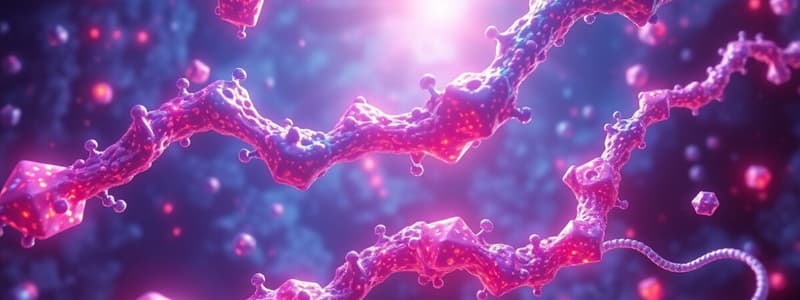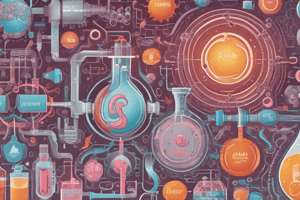Podcast
Questions and Answers
What is the primary role of glucose-6-phosphatase in the liver?
What is the primary role of glucose-6-phosphatase in the liver?
- To transport glucose-6-phosphate to the cytosol
- To convert glucose-6-phosphate into glycogen
- To release glucose from glucose-6-phosphate (correct)
- To initiate glycolysis in the liver
Which statement about the effects of glucagon and epinephrine is accurate?
Which statement about the effects of glucagon and epinephrine is accurate?
- They increase glycogenesis in the liver under low energy conditions
- They stimulate glycogenolysis in the liver during fasting (correct)
- They activate glycogen synthase in muscle tissue
- They inhibit glycogen phosphorylase during hyperglycemia
What leads to the development of Pompe disease?
What leads to the development of Pompe disease?
- Deficiency of the enzyme glucose-6-phosphatase
- Lysosomal enzyme deficiency, specifically of α(1→4)-glucosidase (correct)
- Increased glycolysis in liver cells
- Excessive glycogen storage due to high insulin levels
How does skeletal muscle primarily use glucose-6-phosphate?
How does skeletal muscle primarily use glucose-6-phosphate?
What characterizes Glycogen Storage Disease Type-I (Von Gierke’s disease)?
What characterizes Glycogen Storage Disease Type-I (Von Gierke’s disease)?
What is the primary function of liver glycogen during fasting?
What is the primary function of liver glycogen during fasting?
Which enzyme is responsible for creating the α(1→4) linkages in glycogen during glycogenesis?
Which enzyme is responsible for creating the α(1→4) linkages in glycogen during glycogenesis?
What is produced as a direct result of glycogenolysis after the cleavage of glycogen chains?
What is produced as a direct result of glycogenolysis after the cleavage of glycogen chains?
How does the branching enzyme contribute to glycogen structure?
How does the branching enzyme contribute to glycogen structure?
What is the role of phosphoglucomutase in glycogen metabolism?
What is the role of phosphoglucomutase in glycogen metabolism?
Flashcards
Muscle Glycogen Function
Muscle Glycogen Function
Muscle glycogen provides energy for muscle contractions.
Liver Glycogen Function
Liver Glycogen Function
Liver glycogen maintains blood glucose levels, especially during fasting.
Glycogenesis
Glycogenesis
The process of building glycogen from glucose.
Glycogenolysis
Glycogenolysis
Signup and view all the flashcards
Glycogen Phosphorylase
Glycogen Phosphorylase
Signup and view all the flashcards
Glucose-6-Phosphate Fate in Liver
Glucose-6-Phosphate Fate in Liver
Signup and view all the flashcards
Glucose-6-Phosphate Fate in Muscle
Glucose-6-Phosphate Fate in Muscle
Signup and view all the flashcards
Lysosomal Glycogen Degradation
Lysosomal Glycogen Degradation
Signup and view all the flashcards
Liver and Muscle Glycogen Regulation
Liver and Muscle Glycogen Regulation
Signup and view all the flashcards
Hormonal Control of Glycogen Metabolism
Hormonal Control of Glycogen Metabolism
Signup and view all the flashcards
Study Notes
Glycogen Metabolism
- Glycogen is a storage form of glucose
- Muscles store glycogen for ATP synthesis during contraction
- Liver stores glycogen to maintain blood glucose levels, especially during fasting
- Approximately 400g of glycogen makes up 1-2% of resting muscle weight and 100g makes up to 10% of well-fed adult liver weight
- Glycogen is a branched polysaccharide of glucose, with a-1,4 and a-1,6 glycosidic linkages
- Glycogenesis is the synthesis of glycogen, occurring in the cytosol and needing energy from ATP
- Glycogen synthase makes a-1,4 linkages, and branching enzyme makes a-1,6 linkages
- Glycogenolysis is the breakdown of glycogen, also occurring in the cytosol
- Glycogen phosphorylase cleaves a-1,4 glycosidic bonds at non-reducing ends of glycogen, producing glucose-1-phosphate
Specific Objectives
- Students will be able to differentiate between liver and muscle glycogen function
- Students will be able to discuss the processes of glycogenesis and glycogenolysis
- Students will be able to explain hormonal regulation of glycogen metabolism
- Students will be able to explain the reason for glycogen storage disease type I and II
Structure and Function of Glycogen
- The main stores of glycogen are in skeletal muscle and liver
- Muscle glycogen serves as a fuel reserve for ATP during muscle contraction
- Liver glycogen maintains blood glucose concentration, especially during fasting periods
A. Shortening of Chains (Glycogenolysis)
- Glycogen phosphorylase sequentially cleaves α(1→4) glycosidic bonds at the non-reducing ends of the glycogen chain producing glucose-1-phosphate
B. Removal of Branches
- Branches are removed by a debranching enzyme
- First, a(1→4)-glucan transferase activity removes the outer three glucosyl residues attached at a branch
- Second, amylo-a(1→6)-glucosidase removes glucose at a(1→6) bond
- The glucosyl chain is available again for degradation by glycogen phosphorylase
C. Conversion of Glucose-1-Phosphate to Glucose-6-Phosphate
- This occurs via phosphoglucomutase enzyme in the cytosol
D. Lysosomal Degradation of Glycogen
- A small amount of glycogen (1-3%) is continuously degraded by lysosomal enzyme a(1→4)-glucosidase (acid maltase) in the cytoplasm
- Deficiency of this enzyme leads to glycogen storage disease type II (Pompe disease)
Regulation of Glycogen Synthesis and Degradation
- In the liver, glycogenesis speeds up during well-fed periods, while glycogenolysis speeds up during fasting periods
- In skeletal muscle, glycogenolysis occurs during exercise, followed by glycogenesis when resting
Hormonal Regulation
- Glucagon and epinephrine stimulate glycogen phosphorylase and inhibit glycogen synthase during low blood sugar
- Insulin stimulates glycogen synthase and inhibits glycogen phosphorylase during high blood sugar levels
- Glucagon has no role in muscle
Glycogen Storage Disease Type I
- Also called Von Gierke's disease
- Caused by a deficiency of glucose-6-phosphatase
- Characterized by massive liver enlargement, which can cause cirrhosis
- Children often die in early childhood
- Treatment involves frequent, small food portions
Studying That Suits You
Use AI to generate personalized quizzes and flashcards to suit your learning preferences.



